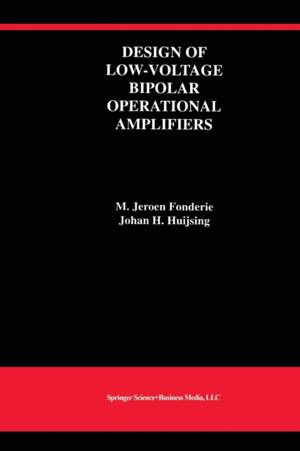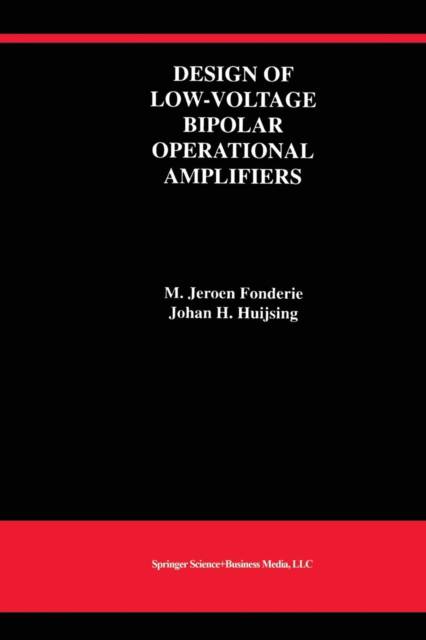
- Afhalen na 1 uur in een winkel met voorraad
- Gratis thuislevering in België vanaf € 30
- Ruim aanbod met 7 miljoen producten
- Afhalen na 1 uur in een winkel met voorraad
- Gratis thuislevering in België vanaf € 30
- Ruim aanbod met 7 miljoen producten
Zoeken
€ 259,45
+ 518 punten
Uitvoering
Omschrijving
Design of Low-Voltage Bipolar Operational Amplifiers discusses the sub-circuits necessary to build a low-voltage operational amplifier. These include rail-to-rail input stages, rail-to-rail output stages, intermediate stages, protection circuitry and frequency compensation techniques. Of each of these, various implementations are examined. Furthermore, the book discusses realizations in silicon of the amplifiers.
The design and implementation of low-voltage bipolar Operational Amplifiers (OpAmps) is fully presented. A low supply voltage is necessary because the tendency towards chip components of smaller dimensions lowers the breakdown voltage of these components. Further, a low supply voltage is favorable because it enables operation of the OpAmp from just one single battery cell. The bipolar technology is chosen, because it is more suited for operation at low-voltages than the MOS technology.
The common-mode input voltage of the OpAmp must be able to have any value that fits within the supply voltage range. Input stages are discussed which are able to realize this at supply voltages down to 1.8 V, as well as down to 1 V.
The output voltage of the OpAmp must be able to have any value within the supply voltage range. One of the 1 V output stages that is discussed, the multi-path driven output stage, also has a high bandwidth with a high gain.
In addition to the input and output stage, the OpAmp comprises an intermediate stage, between the input stage and the output stage, to boost the overall gain of the OpAmp, and a class AB current control.
A frequency compensation technique is used to split apart the pole frequencies in the transfer function. A disadvantage of this nested Miller compensation, is that the resulting bandwidth is reduced by a factor of two. A new method, multi-path-driven Miller compensation, which does not have this drawback, is therefore introduced.
Several realizations are evaluated and a figure of merit is defined for the performance comparison of the OpAmps. One of the OpAmps operates at a 1 V supply, has a 3.4 MHz bandwidth with a 100 pF load and has a 700 &mgr;A supply current.
The book is an excellent reference for professional designers of amplifiers and may be used as a text for advanced courses on the subject.
The design and implementation of low-voltage bipolar Operational Amplifiers (OpAmps) is fully presented. A low supply voltage is necessary because the tendency towards chip components of smaller dimensions lowers the breakdown voltage of these components. Further, a low supply voltage is favorable because it enables operation of the OpAmp from just one single battery cell. The bipolar technology is chosen, because it is more suited for operation at low-voltages than the MOS technology.
The common-mode input voltage of the OpAmp must be able to have any value that fits within the supply voltage range. Input stages are discussed which are able to realize this at supply voltages down to 1.8 V, as well as down to 1 V.
The output voltage of the OpAmp must be able to have any value within the supply voltage range. One of the 1 V output stages that is discussed, the multi-path driven output stage, also has a high bandwidth with a high gain.
In addition to the input and output stage, the OpAmp comprises an intermediate stage, between the input stage and the output stage, to boost the overall gain of the OpAmp, and a class AB current control.
A frequency compensation technique is used to split apart the pole frequencies in the transfer function. A disadvantage of this nested Miller compensation, is that the resulting bandwidth is reduced by a factor of two. A new method, multi-path-driven Miller compensation, which does not have this drawback, is therefore introduced.
Several realizations are evaluated and a figure of merit is defined for the performance comparison of the OpAmps. One of the OpAmps operates at a 1 V supply, has a 3.4 MHz bandwidth with a 100 pF load and has a 700 &mgr;A supply current.
The book is an excellent reference for professional designers of amplifiers and may be used as a text for advanced courses on the subject.
Specificaties
Betrokkenen
- Auteur(s):
- Uitgeverij:
Inhoud
- Aantal bladzijden:
- 193
- Taal:
- Engels
- Reeks:
- Reeksnummer:
- nr. 218
Eigenschappen
- Productcode (EAN):
- 9781461363750
- Verschijningsdatum:
- 22/12/2012
- Uitvoering:
- Paperback
- Formaat:
- Trade paperback (VS)
- Afmetingen:
- 156 mm x 234 mm
- Gewicht:
- 299 g

Alleen bij Standaard Boekhandel
+ 518 punten op je klantenkaart van Standaard Boekhandel
Beoordelingen
We publiceren alleen reviews die voldoen aan de voorwaarden voor reviews. Bekijk onze voorwaarden voor reviews.








